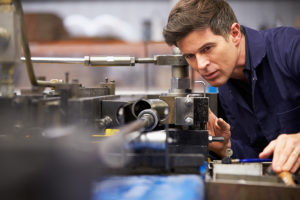There are many types of measurement systems available for use in your production line. The advantages of each method are dependent upon many variables. Important factors include the dimensions of the shape, required tolerances, and the desired speed of measurement. The following definitions are to help understand the various terms when discussing measurement systems.
Flag Trip
This is the simplest of all measuring systems as it involves only a light plate attached to a pivot pin. When the traveling part impacts the plate, it trips a switch that fires the press. The cutoff blade entering the traveling part locks the die to the material through the cutoff cycle. Another option is to mount a photo cell to an adjustable bracket on the run-out table. In this variation, the end of the part breaks the beam to trip the press.
Positive Stop
A vertically-mounted traveling plate is attached back to the die by a rod. The stop is adjustable and able to lock along this pull rod for the desired cut length. The part end, hitting the stop, pulls the die forward which activates a switch and trips the press. When the cutoff blade enters the material, the stop is lifted either mechanically or by power so that the part can pass underneath. The stop then returns to its standing, lowered position ready for the next measuring cycle.
Pilot Pick Up
This is a method where a finger pilot drops into a pre-punched slot in the material. The pilot dropping into the slot locks the die to the traveling material throughout the cutting cycle. The die then trips the press at the bottom of the cutoff stroke. Finally, the pilot retracts, allowing the die to return to its resting position.
Electronic Rotary Encoding
A technique whereby a wheel riding the material outputs a given number of pulses per revolution. The controller converts the pulses to a pre-set length, which then outputs a signal.



